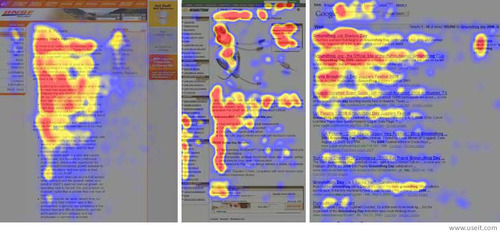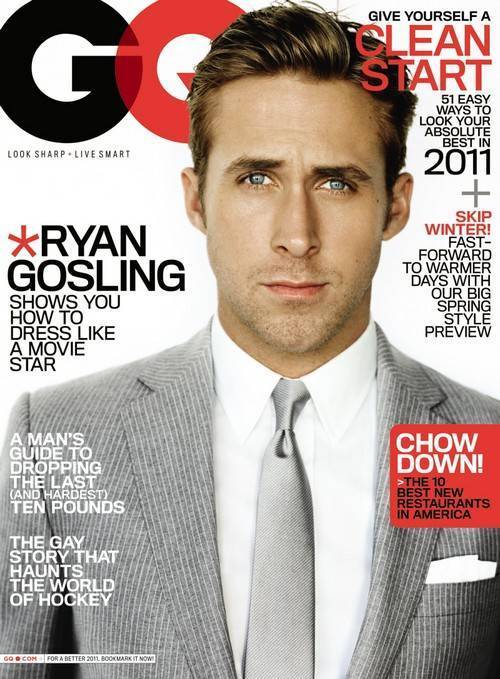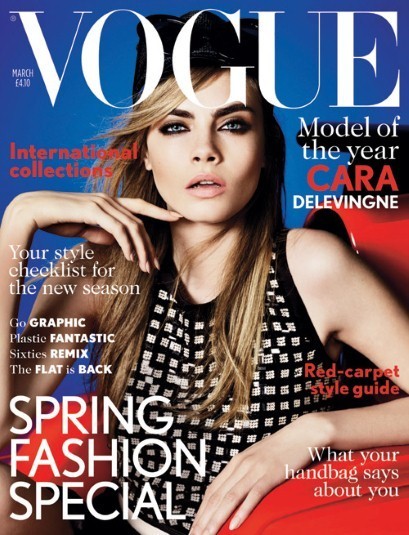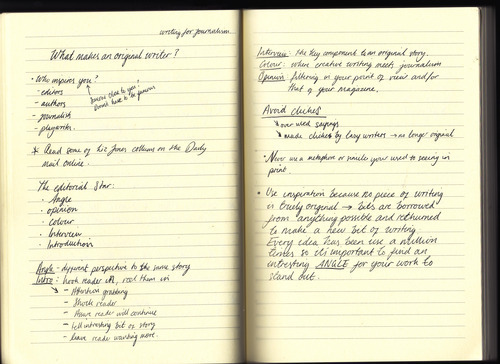#writingforjournalism
Explore tagged Tumblr posts
Text
Writing for Journalism Reflection- Week 3
In week 3 of Writing for Journalism we learnt about professional etiquette and employability in both journalism and photography. We were taught about traditional and modern ways in which you can break into the industry and what you can do to improve etiquette. In the second session of the week we learnt how to sub-edit. We were taught about the various things you need to look out for when sub-editing a piece of text. We were then given a raw copy of text which we had to edit and flow into a double-page spread on InDesign. This session taught me a lot more about how to create a feature article using InDesign and I am now quite confident in doing this with the aid of notes taken from the lecture.
0 notes
Text
Primary Research for my Articles:

Interview 1

Interview 2
0 notes
Text
Week 7
This week was a reading week so i looked other books and pieces of writing that would help me with my final article.
Especially for any article, its important that that good quotes from the interview can be blow up to draw in readers. When you first look at an article the first things that draw you in are the headline, the byline and the writing in bold.
"A good quote, like good writing, evokes images in the reader’s mind." [1] I take from this that pulled interesting sections of an interview would be the best way to get readers.
[1] Rogers, T. (2012). Getting ‘good’ quotes for news stories: http://journalism.about.com/od/reporting/a/goodquotes.htm.
0 notes
Text
Week 6: Photography and Journalism
Photography and Journalism go hand in hand. Photography draws you towards an article, and a small section of writing can help you show people the depth of your photography. Being able to write the article and take the pictures will set you apart from other journalists.
The hardest part of writing an article is trying to find the right angle. The subject may have been written about a million times, but a different angle could completely change it. An editor 'want[s] the idea to be almost fully formed so that they can picture how it would look on a page.' So if you have an interesting angle, photographs and even and interview the editor will have to do very little to make it ready for publication.
Although, Photography is so common these days, anyone with a smart phone and instagram can claim to be a photographer, so if you were pitching to an editor for both your writing and your photography, research the magazine and lead with what they put more emphasis on.
Photography can also show that you've gone that extra mile when writing the article. If the photography is good, it may lead to an editor keeping your name in mind when looking for photographers.
There is a lot to think about when pitching, and there's a lot of room for individual differences from editor to editor, but knowing the magazine inside out is the only thing that can help you get round that.
Notes From the Lecture:
Modes of Writing:
Creative
Academic
Professional
Personal
Marketing
Pitch:
Your pitch is your story idea, You have to sell your story and yourself as a writer. Its your one chance you get to impress your commissioning editor.
What makes a good pitch?
Must be:
Informative
Instantly Interesting
Believable - convince reader of an original story
Thought provoking
Must leave the reader wanting more
Be written in a suitable tone
Persuade reader
How do you get an editor to notice you?
BAIT - Temp editor, don't give to much away.
The only way to know what the editor wants is to know the magazine inside out.
How it works, sections, style, departments, approach
The Angle
The angle is CRUCIAL.
An interesting take on the subject, something the editor hasn't seen before.
Check age and social class profile of magazine before you do your pitch
Access:
Email
Ask, twitter, google?
You need a compelling reason why you are the right person to commission
Have you got privileged access?
Past history?
Were you 'on the spot'?
Convince editor you have the best facts - do the leg work for them, case studies, proof ect
Ask yourself what makes your story special - If it doesnt convince you, it wont convince an editor
Things to Avoid:
Formality
Waffle
Hyperbole
If your email goes unanswered for 2 weeks send it again, it goes ignored after that there not intrested.
Try and find out the production schedule of the magazine your pitching to.
BAIT + ANGLE +ACCESS = GOOD PITCH
http://journograds.com/2013/08/08/how-to-pitch-your-story-to-editors/
0 notes
Text
Week 5
Who are these magazines aimed at?:
http://www.drapersonline.com/ - People who work in the fashion industry. Articles are designed for people who work more behind the scenes. This is a niche market and was not made for a wider target audience.
http://www.broadcastnow.co.uk/ - This website is alot like a TV guide, but with a more in depth description of the show and their view on it. I would say there target audience would be older people who watch TV. I would say older because most young people watch TV on demand and wouldn't necessarily read a review on a show, they'd decide if they wanted to watch the show based on the advert.
http://www.campaign-magazine.co.uk/ -
Lots of companies that run through websites now also create subscription magazines. Businesses like ASOS send out monthly magazines to there customers to show there new products for the coming season.
"In terms of quantities of copies sold, consumer magazines dominate the news stands […] the best selling magazines are general men and womens titles"
Being as the best selling magazines are womens and mens titles, for companies like ASOS, who can fit in both categories with one magazine, it is almost guaranteed in interest there target audience.
[1] Jason Whittaker, Magazine Production 2008, Page 14
0 notes
Text
Week 8: Same Story Different Platform
The diagram below is of the F shaped reading pattern. This pattern is dominant reading pattern of web users. It shows where people are most observant and least. It also proves that most people just scan an article and don't actually read the whole thing, this is why breaking up the article is so important.
The main points that the F shape pattern show is that, firstly, the text will not be read thoroughly. Most readers will overlook a lot of what is written, especially if it longer piece of writing. Secondly, the first two paragraphs are the most important. All the important information and basic of the article should be put into these paragraphs so that reader can gain most of the information from the article without having to read the whole thing. Thirdly, bullet points, lists and quotes should be used as they will catch the readers attention when scanning down the left hand side of the page. This may even encourage them to read the whole article.

With online articles, you can gain thousands of new readers and popularity practically overnight with the use of sharing icons.
" To build a thriving blog, you also need to learn to drive traffic to it. Share your article on other social networks. Pinterest, Vine, Storify, Digg, Quora, Reddit, StumbleUpon, and Care2 are just some of the many options for sharing your work.”
Social Networks allow other people who like your article to share it. This is not only free advertising for your writing, but it may bring you to the attention of more people in your target audience.
Just now on my homepage was a saw at least 5 shared articles, this particular one was about the treatment of women in the music industry.

Keeping your reader engaged is important. Whether its engaged in a specific article or your blog as a whole
In print, this F shaped pattern is not as dominant so they can be layed out differently. With print, you are always first caught by glossy covers and clever cover lines.
'Print publications — from newspaper articles to marketing brochures — contain linear content that's often consumed in a more relaxed setting and manner than the solution-hunting behavior that characterizes most high-value Web use.
In print, you can spice up linear narrative with anecdotes and individual examples that support a storytelling approach to exposition. On the Web, such content often feels like filler; it slows down users and stands in the way of their getting to the point.'
In writing for print you have more characters, this allows you to not have to be so direct. Your words can flow for a paragraph without being interrupted with lines and lines of evidence and data. Print allows you to have more of a personality to your work.
http://www.nngroup.com/articles/f-shaped-pattern-reading-web-content/
Dorie Clark and Daniel Vahab, Forbes,2013) http://www.forbes.com/sites/dorieclark/2013/11/01/how-to-drive-more-traffic-to-your-blog/
http://www.nngroup.com/articles/writing-style-for-print-vs-web/
0 notes
Quote
Be in control. This is very important. You are the professional.
John Herbert
0 notes
Text
Writing for Journalism, Week 10

http://www.dafont.com/


Working with InDesign is a core skill needed in the journalism industry. The seminar consisted of working with the programme to create front covers of magazines. This in turn helps us to understand the layout, structure and meaning of what's on a front cover, why it is there and what the editors intentions are.



The fonts used were from a font data base, dafont.com. The selection of fonts are excellent as you can really explore and experiment with sans and sans seriff fonts.

The gradient tool was also very helpful. The text 'Isabel Marrant' stands out a lot more than it would if it were a plain block colour as the eye is immediately drawn to the colours. Also mixing it up by using different font and colours helps the layout to look less tired and boring and therefore more engaging for the potential readership.


Image references- http://marantphiles.com/category/about-the-designer/ http://www.isabelmarant.com/en/ http://www.gngcreative.com/newsletters/nl9.html
0 notes
Text
What makes an original writer?

I thought that this lecture on original writing was very interesting. So many ideas have been done so many times that there is no formula to make your writing original. Finding that small slice of originality really comes down to having a wide and varied platform to draw and borrow from. The more you read the more styles of writing you find, the more artists you look at the more mediums you find. Everything is down to research and finding what you like, because every writer has a style they primarily like to write in. And finding that is a start.
0 notes
Text
Week 9: Analytical Exercise
The journey from 23 Winston Gardens to Headingley campus involved, waking up, having a shower, feeding the rabbit and walking to uni.
The days events could have been improved by waking up early so everything wouldn't of had to be done in a rush and other tasks could of also been done in that time, like making a cup of tea, eating breakfast and and spending some quality time with Pheobe the rabbit. Although saying this, all the most important task were achieved, i.e having a shower, getting dressed and turning up to uni on time.
The temperature in Leeds, although still lower that that in the south of England, is dropping. The BBC descibes it as 'cloudy, breezy and damp .... with outbreaks of rain.'
http://www.bbc.co.uk/weather/2644688
0 notes
Text
Week 9: Descriptive Exercise
There are many ways to describe my journey to university today, most of them swear words and none i should probably write down. Before i'd even left the house the shower, as always, was cold as hell, my clothes still weren't dry even though i've left them out for a good day because i live in a basement and the heating is to expensive to put on, and i didn't have time to make a cup of tea. I fed my rabbit Pheobe at around 11, and she was as always, loving life and stuffing her abnormally large face with food.
After i had mentally recovered from all this trauma, i attempted to leave the house at around twenty five too 12. After a good five minuets of shouting why wont this door open and staring at it, i was informed by one of my house mates that the bolt was still on and all i had to do was slide that open and life would again be good. Without turning to look at her raised eyebrow and shaking head, i left the house with the small bit of dignity i had left.
Nothing too horrible happened on the walk to uni, it was cold but this is Leeds so i don't know why i always think that it will be a reasonable temperature when i leave the house.
i arrived on campus into what can only be describe as a building with more moving hallways than hogwarts. I swear i go i different way every time and i still somehow find a way to my lecture room. Im am certain that one day i will find the 3rd floor corridor and release the troll myself.
0 notes
Text
Feature Research
For my feature i wanted to do a opinion piece on teenage fiction. I wanted to center around the idea that more more books that are written for a teenage audience are being read by older women. I want to find out what authors think about this phenomenon, and if thy wrote the book for that specific audience or was this decided after the book was written by publicists.
Things i need to do:
1. Interview with an author
- Research authors who sell popular teenage fiction, find out which ones might realistically talk to me,
2. Interview with an older person who likes to read teenage fiction - Pull quotes up in bold
- Im thinking middle aged woman, ask why they enjoy reading teenage fiction apposed to book made for there own age
3.Photograph author if i can get the interview face to face
4. More initial research on sales of Teenage fiction
- Numbers sold, money made, how big the genre is, leading author
0 notes
Text
Week 6: Start of my article for Task 2
This is the beginning of my Task 2 article created on InDesign.
0 notes
Text
Week 6, Photography and Journalism
Creative
Editorial
Academic
Professional
Personal
Marketing
What is a pitch?
Putting your idea forward
Selling your story idea- and yourself
The one chance you get to impress a commissioning editor (by coming up with new ideas)
What makes a good pitch?
Be instantly interesting
Informative
Believable
Thought-provoking
YOU MUST Leave the reader wanting to know more
Convince the reader that you have an original story
Give clear direction and detail
Persuade
Be written in a suitable tone
How do you get noticed? Bait... Tempt the editor, make them want to read your work, but don't give too much away. Pitches are usually sent via email, Be different, be unique! - Letters, pictures, collages, mood boards ect. “The only way to know what the editor wants is to know the magazine inside out. Subject matter, style, approach. You also need to know how the magazine works, the sections and departments”- [6] “You have to have an interesting take on the subject, something the editor hasn’t already seen a hundred times” [7] "The angle is crucial. If the story is an old favourite, make sure the angle is a fresh one that will appeal to the magazines core readership"- [8]
Make your idea topical for monthlies
Weeklies will want more immediate stories with a newsy hook.
Find out magazines production schedules, this enables you to plan in advance what you can pitch to commissioning editors. Planning in advance is never a bad thing- Christmas editions, valentines day ect. These holidays are always planned and ready months before they're due to be published Access; - You need a compelling reason as to why your the right person. - Privileged access? - Past history? - Were you 'on the spot'?
"Basically why should the editor give the story to you?" [9]
"Do the leg work for them. Have your case study ready for your pitch, and remember that increasingly good cast studies have to look right for the mag” [10]
Bait + Angle + Access + Interesting + Informative + Believable + Entertaining + Thought Provoking= A Good Pitch
[1] [3] [4] [5] Journalism.co.uk, Press release 2013 "What to say when others have said it all" Available: http://www.journalism.co.uk/press-releases/what-to-say-when-others-have-said-it-all/s66/a554147/) [2] Richard Lynch. Good photography techniques. What makes a good photo? Available: http://www.betterphoto.com/article.asp?ID=224 [6] [7] [9] Andrew Humphreys. Ink Publishing. [8] [10]Jo Waters. Freelance journalist and commissioning editor for Yours magazine.
0 notes
Text
Writing for Journalism- Week 1.
During our first lecture the topic discussed was mainly feature writing, house styles of magazines we like to read and interviewing. The reading assigned was Whittaker (2008) and after reading the work based on features didn't seem as daunting as they were at first. "The majority of features that appear in consumer magazines and newspaper supplements are lifestyle features: many magazines include little else and may be broken down into the following categories: Health and Fitness; Fashion and Beauty; Leisure and Hobbies; Relationships and Sex; Homes and Gardens; Food, and Travel." [1] London Fashion Week. Fashion magazines have always been very popular due to their high demanding demographic and hugely changing topic- there is always something new.
"Someone of extensive experience like his can speak with great authority on a subject, and his thoughts can make for fascinating journalism. So if the topic seems stale, refresh it!" [3] Journalism.co.uk (what to say when someone has said it all) September 2013. Another interview possibility would be fashion bloggers who have traveled to be at the event their views, ideas and thoughts. The project could focus more on an angle of Designer vs. High-street which would be very popular for Cosmopolitan and Look as these blogs are aimed at young adults who would buy into high-street fashion. Also looking at fashion blogs, trend forecasters and making the article more 'do-able' to the readers. Other points for this angle is the main 'high street' focus as this is more relevant to our demographic. This exercise was particularly eye opening as it was the first time the group had been asked to pitch an idea. Now as you can imagine this is going to have to be a key skill when graduating. Whether our career path involves working directly with a magazine or newspaper, at some point in our careers we will need to start selling ourselves and selling our ideas to commissioning editors. Using this task to look at our own ideas in more depth and looking at possibilities to expand on that was very fascinating and helped a great deal in making this situation more comfortable for us students.
[1] Jason Whittaker. (2008) Routledge Magazine Production. Page 89. [2] Jason Whittaker. (2008) Routledge Magazine Production. Page 89. [3] Journalism.co.uk (what to say when someone has said it all) September 2013.
0 notes
Text
Writing for Journalism Reflection- Week Two
Our second week of the Writing for Journalism module was primarily based on the development of our professional CV's. We were taught to do this in InDesign, a program I hadn't really used before but found quite easy to pick up as it is similar to other Adobe programs such as PhotoShop and Illustrator which I am pretty confident in using. We were also taught that even if you lack experience in professional journalism, you can mould things you have done into 'Industry Skills', which employers may be interested in. I think the most helpful part of this workshop was learning the basics of Adobe InDesign which I am going to use in the coming weeks to further develop the CV I started to create in the session.
0 notes